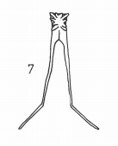Sphenolithus furcatolithoides
Set number: 950
-
1
-
2
-
3
-
4
-
5
-
6
-
7
-
8
-
9
-
10
-
11
-
12
10µm
Sphenolithus furcatolithoides Locker, 1967
Sphenolithus furcatolithoides labradorensis Firth,1989
Sphenolithus cuniculus Bown, 2005d
Species of Sphenolithus Deflandre in Grassé, 1952 have a low frustum shape proximal cycle with a conical proximal cavity, a very low lateral cycle [can only be seen using a gypsum plate at 45°] and a bifurcated duolithic apical spine with an inclined extinction.
The bifurcated duolithic apical spine with an axial median line shows maximum birefringence at 0° and extinct (dim) at 45° (inclined extinction-optic axes are not parallel to the crystallographic axis].
The bifurcation of the apical spine can start at a different distance from lateral elements.
Sphenolithus furcatolithoides differs from Furcatolithus obtusus, (Bukry, 1971b) Howe, 2021 by having a very low lateral cycle and a bifurcated apical spine with an inclined extinction (45°). The latter is lacking a lateral cycle and has a non-bifurcated apical spine with an oblique extinction (22°).
Sphenolithus furcatolithoides labradorensis Firth (1989) is identified based on where the bifurcation started. This is a very subjective criterion to adopt.
Sphenolithus cuniculus Bown, 2005d is identified by having very low proximal and lateral cycles and a broader apical spine. We believe it is a preservational morphotype of Sphenolithus furcatolithoides.
Bown, P. R., 2005d. Palaeogene calcareous nannofossils from the Kilwa and Lindi areas of coastal Tanzania (Tanzania Drilling Project 2003-4). Journal of Nannoplankton Research 27(1), 21-95.
Bukry, D., 1971b. Cenozoic calcareous nannofossils from the Pacific Ocean. - San Diego Society of Natural History Transactions 16, 303-327.
Firth, J. V., 1989. Eocene and Oligocene calcareous nannofossils from the Labrador Sea, ODP Leg 105. Proceedings of the Ocean Drilling Program, Scientific Results 105, 263-286.
Locker, S., 1967. Neue Coccolithophoriden (Flagellata) aus dem Alttertiär Norddeutschlands. Geologie, Berlin 16, 361-364.

